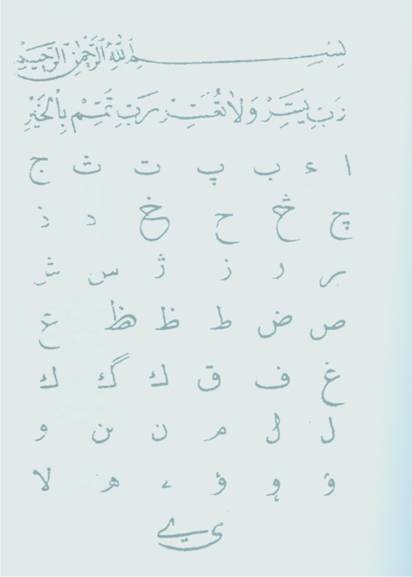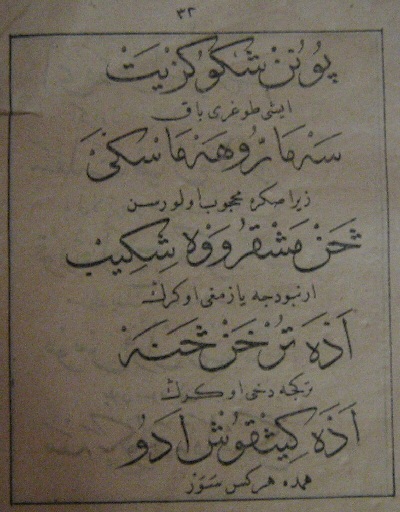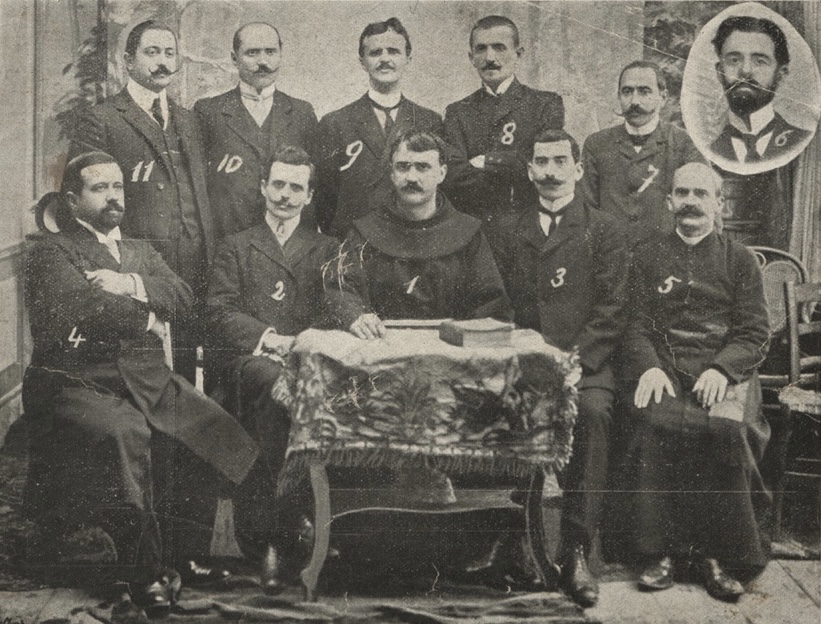|
Elifba
The Elifba alphabet ( sq, Elifbaja, from ota, الفبا, Elifbâ) was the main writing system for the Albanian language during the time of the Ottoman Empire from 14th century to 1911. This Albanian variant of the Abjad Ottoman was used to write the Albanian language. The last version of the ''Elifbaja shqip'' was invented by the rilindas, Rexhep Voka (1847-1917). History The Ottoman Turkish alphabet was mainly favored by Albanian Muslims, but also used by some Christians. After being especially used during the Bejte poetry, a primer for the Albanian language in Arabic script was published in 1861 in Constantinople by Mullah Daut Boriçi, a prominent member of the League of Prizren. During 1909 and 1910 there were movements by Albanian Young Turks supporters to adopt the Arabic alphabet, as they considered the Latin script to be un-Islamic. In Elbasan, Muslim clerics led a demonstration for the Arabic script, telling their congregations that using the Latin script would ... [...More Info...] [...Related Items...] OR: [Wikipedia] [Google] [Baidu] |
Elifbaja Shqip
The Elifba alphabet ( sq, Elifbaja, from ota, الفبا, Elifbâ) was the main writing system for the Albanian language during the time of the Ottoman Empire from 14th century to 1911. This Albanian variant of the Abjad Ottoman was used to write the Albanian language. The last version of the ''Elifbaja shqip'' was invented by the rilindas, Rexhep Voka (1847-1917). History The Ottoman Turkish alphabet was mainly favored by Albanian Muslims, but also used by some Christians. After being especially used during the Bejte poetry, a primer for the Albanian language in Arabic script was published in 1861 in Constantinople by Mullah Daut Boriçi, a prominent member of the League of Prizren. During 1909 and 1910 there were movements by Albanian Young Turks supporters to adopt the Arabic alphabet, as they considered the Latin script to be un-Islamic. In Elbasan, Muslim clerics led a demonstration for the Arabic script, telling their congregations that using the Latin script wo ... [...More Info...] [...Related Items...] OR: [Wikipedia] [Google] [Baidu] |
Albanian Alphabet
The Albanian alphabet ( sq, alfabeti shqip) is a variant of the Latin alphabet used to write the Albanian language. It consists of 36 letters: ''Note:'' The vowels are shown in bold. The letters are named simply by their sounds, followed by ë for consonants (e.g. fë). to the pronunciation of the 36 letters. History The earliest known mention of Albanian writings comes from a French Catholic church document from 1332. Written either by archbishop Guillaume Adam or the monk Brocardus Monacus the report notes that ''Licet Albanenses aliam omnino linguam a latina habeant et diversam, tamen litteram latinam habent in usu et in omnibus suis libris'' ("Though the Albanians have a language entirely their own and different from Latin, they nevertheless use Latin letters in all their books"). Scholars warn that this could mean Albanians also wrote in the Latin language, not necessarily just Albanian with a Latin script. The history of the later Albanian alphabet is closely linked w ... [...More Info...] [...Related Items...] OR: [Wikipedia] [Google] [Baidu] |
Rexhep Voka
Nuredin Rexhep Voka (1847 - 1917) was an Albanian alim, mufti, writer and a prominent activist of the Albanian National Awakening. Biography Rexhep Voka was born in 1847 in the village of Şipkovica, Tetovo. In 1868, Voka undertook religious studies in Istanbul where he worked as a professor after completing his education. Voka returned to Kalkandelen in 1895 where he became involved in the Albanian National Renaissance. In 1903, Voka was appointed Mufti of the Manastir Vilayet and founded the first Albanian theological college in Üsküb (today Skopje). In Monastir, before the Young Turk revolution, Voka started learning Albanian in Latin characters from Albanian Protestant missionaries. In 1905, Voka attended the Pan-Albanian Congress organized in Bucharest. Headed by Albert Ghica, attended by Ismail Qemali and deliberated with Bucharest's Albanian community, the congress discussed the Albanian issue. Rexhep Voka was a member of ''Bashkimi'' (Unity) at the time of the Young Tur ... [...More Info...] [...Related Items...] OR: [Wikipedia] [Google] [Baidu] |
Daut Boriçi
Mollà Daut Effendi Boriçi ( tr, Davut Şükrü Efendi, 20 December 1825 – 2 November 1896), was an Albanian alim, müderris and nationalist figure of the Albanian National Awakening. For most of his life he was involved in the Ottoman educational system, and is remembered for his Albanian primer in Arabic alphabet of 1861, and his leadership during the League of Prizren. Life Boriçi was born in Shkodër, back then center of the Pashalik of Scutari of the Ottoman Empire. His family originates from Boriç village near Antivari, today's Montenegro, having settled in Shkodër around 1650. At 8 years old he started his elementary education together with his brother Salih in the local school located in the "Old Bazaar" mahala. There he was taught by Molla Ferhati (1773-1844). During his youth, Boriçi also attended the Greek high school Zosimea in Janina for his education. In 1839 he started learning the Arabic language and studying theology with the '' müderris''-es of the ... [...More Info...] [...Related Items...] OR: [Wikipedia] [Google] [Baidu] |
Bejte
The Bejtexhinj (in Albanian sing. ''bejtexhi'', pl. ''bejtexhinj''; from tr, beyte meaning "poem"), were popular bards of the Muslim tradition, literally meaning " couplet makers". It means the same in the Albanian literature, firstly muslim poets, that engaged in beit poetry. This genre of literature created in Albania in the 18th century that prevailed in different cities of what is now Albania, Kosovo, Chameria as well as in religious centers. The spread of Bejtexhinj was a product of two different significant factors. There was a demand in religious practices to write in Albanian and to free it from foreign influence. The other factor was the accretion of ideological pressure from Turkish rulers. The ruling Ottomans sought the submission of Albanians through the Muslim religion and culture. Albania rulers opened their own schools with many Bejtexhinj poets in attendance. History The Bejtexhinj wrote Albanian in the Elifba alphabet, an adaption of the Ottoman Turkish ... [...More Info...] [...Related Items...] OR: [Wikipedia] [Google] [Baidu] |
Arabic Script
The Arabic script is the writing system used for Arabic and several other languages of Asia and Africa. It is the second-most widely used writing system in the world by number of countries using it or a script directly derived from it, and the third-most by number of users (after the Latin and Chinese scripts). The script was first used to write texts in Arabic, most notably the Quran, the holy book of Islam. With the religion's spread, it came to be used as the primary script for many language families, leading to the addition of new letters and other symbols. Such languages still using it are: Persian (Farsi/Dari), Malay ( Jawi), Uyghur, Kurdish, Punjabi (Shahmukhi), Sindhi, Balti, Balochi, Pashto, Lurish, Urdu, Kashmiri, Rohingya, Somali and Mandinka, Mooré among others. Until the 16th century, it was also used for some Spanish texts, and—prior to the language reform in 1928—it was the writing system of Turkish. The script is written from right to left in a cu ... [...More Info...] [...Related Items...] OR: [Wikipedia] [Google] [Baidu] |
Albanian National Awakening
The Albanian National Awakening ( sq, Rilindja or ), commonly known as the Albanian Renaissance or Albanian Revival, is a period throughout the 19th and 20th century of a cultural, political and social movement in the Albanian history where the Albanian people gathered strength to establish an independent cultural and political life as well as the country of Albania. Prior to the rise of nationalism, Albania remained under the rule of the Ottoman Empire for almost five centuries and the Ottoman authorities suppressed any expression of national unity or national conscience by the Albanian people. There is some debate among experts regarding when the Albanian nationalist movement should be considered to have started. Some sources attribute its origins to the revolts against centralisation in the 1830s, others to the publication of the first attempt by Naum Veqilharxhi at a standardized alphabet for Albanian in 1844,Zhelyazkova, Antonina (2000). "Albanian Identities". Sofia: ... [...More Info...] [...Related Items...] OR: [Wikipedia] [Google] [Baidu] |
Writing Systems
A writing system is a method of visually representing verbal communication, based on a script and a set of rules regulating its use. While both writing and speech are useful in conveying messages, writing differs in also being a reliable form of information storage and transfer. Writing systems require shared understanding between writers and readers of the meaning behind the sets of characters that make up a script. Writing is usually recorded onto a durable medium, such as paper or electronic storage, although non-durable methods may also be used, such as writing on a computer display, on a blackboard, in sand, or by skywriting. Reading a text can be accomplished purely in the mind as an internal process, or expressed orally. Writing systems can be placed into broad categories such as alphabets, syllabaries, or logographies, although any particular system may have attributes of more than one category. In the alphabetic category, a standard set of letters represent speech ... [...More Info...] [...Related Items...] OR: [Wikipedia] [Google] [Baidu] |
Ottoman Albania
Albania under the Ottoman Empire refers to a period in Albanian history from the Ottoman conquest in the late 15th century to the Albanian declaration of Independence and official secession from the Ottoman Empire in 1912. The Ottomans first entered Albania in 1385 upon the invitation of the Albanian noble Karl Thopia to suppress the forces of the Serbian noble Balša II during the battle of Savra. They had some previous influence in some Albanian regions after the battle of Savra in 1385 but not direct control. The Ottomans placed garrisons throughout southern Albania by 1420s and established formal jurisdiction in central Albania by 1431. Even though The Ottomans claimed rule of all Albanian lands, most Albanian ethnic territories were still governed by medieval Albanian nobility who were free of Ottoman rule. The Sanjak of Albania was established in 1420 or 1430 controlling mostly central Albania, while Ottoman rule became more consolidated in 1481, after the fall of Shkodra a ... [...More Info...] [...Related Items...] OR: [Wikipedia] [Google] [Baidu] |
Congress Of Manastir
The Congress of Manastir ( sq, Kongresi i Manastirit) was an academic conference held in the city of Manastir (now Bitola) from November 14 to 22, 1908, with the goal of standardizing the Albanian alphabet. November 22 is now a commemorative day in Albania, Kosovo and North Macedonia, as well as among the Albanian diaspora, known as Alphabet Day ( sq, Dita e Alfabetit). Prior to the Congress, the Albanian language was represented by a combination of six or more distinct alphabets, plus a number of sub-variants. Participants The congress was held by the Union Association (Albanian language: Bashkimi) literary society at the house of Fehim Zavalani, which served as the headquarters of the union. The participants of the congress were prominent figures of the cultural and political life from Albanian-inhabited territories in the Balkans, as well as throughout the Albanian diaspora. There were fifty delegates, representing twenty-three Albanian-inhabited cities, towns, and cultural ... [...More Info...] [...Related Items...] OR: [Wikipedia] [Google] [Baidu] |
Ottoman Empire
The Ottoman Empire, * ; is an archaic version. The definite article forms and were synonymous * and el, Оθωμανική Αυτοκρατορία, Othōmanikē Avtokratoria, label=none * info page on book at Martin Luther University) // CITED: p. 36 (PDF p. 38/338) also known as the Turkish Empire, was an empire that controlled much of Southeast Europe, Western Asia, and Northern Africa between the 14th and early 20th centuries. It was founded at the end of the 13th century in northwestern Anatolia in the town of Söğüt (modern-day Bilecik Province) by the Turkoman tribal leader Osman I. After 1354, the Ottomans crossed into Europe and, with the conquest of the Balkans, the Ottoman beylik was transformed into a transcontinental empire. The Ottomans ended the Byzantine Empire with the conquest of Constantinople in 1453 by Mehmed the Conqueror. Under the reign of Suleiman the Magnificent, the Ottoman Empire marked the peak of its power and prosperity, as well a ... [...More Info...] [...Related Items...] OR: [Wikipedia] [Google] [Baidu] |








